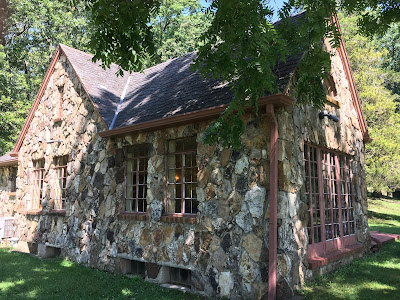 |
| The Laura Ingalls Wilder Museum |
 |
| The Farmhouse |
 |
| Side-view of the Farmhouse |
As I was leaving the museum, a woman was walking up to the steps with a little girl all decked out in full Little House on the Prairie clothing. It was cute to see a child so excited about books; I'm happy that still happens. From the museum, it is just a short walk to the home Laura and Almanzo lived in for so many years. Laura died in one of the house's two bedrooms in 1957, but no one seems sure if she died in her room or in the bedroom that Almanzo used before his own death. My group was a little too large to be led by a guide, so we were each given a brochure and allowed to wander around the little house on our own. A docent was there to answer questions about the home furnishings, what was in the roped off upstairs area, which bedroom was which, etc. This is a very small house but it was so cleverly designed that it must have been very comfortable for the Wilder family. Its design, in fact, reminds me of some of the tricks that RV designers use to make their limited space so livable.
 |
| The Rock House |
Not too many miles down the road, I decided to stop in at a McDonald's on the highway to grab a breakfast sandwich (for lunch) and got another of those little surprises I always hope for. This is Amish country (Missouri is said to have the seventh largest Amish population in the country), and two pairs of Amish teens were waiting for their orders and ice cream cones. They had pulled up in separate black buggies, and their horses were tethered to a bright red hitching post that McDonald's placed in a corner of the parking lot for them. They were very quiet, and gave me the impression that they did not quite feel comfortable waiting around for their food in a crowd. I found myself standing next to one of the girls and she smiled when I told her good morning, so maybe it's just me projecting my own feelings onto them.
Thirty minutes after getting back on the road I stopped off at the Wilson's Creek National Military Park. This was the site of the first Civil War battle in the state of Missouri, and it was a decisive victory for the Confederacy. The park has a very different feel from all the others I've visited over the years because there is only one monument inside the entire park. All the others I've visited are practically covered in large monuments financed by state governments or Civil War veteran groups wanting to honor their fallen comrades. Probably because Wilson's Creek did not become a National Park until 1961, the money for patriotic monuments was just not there. But that's not necessarily a bad thing because Wilson's Creek looks much more like it did during the war than the others do. It's got a very clean look to it.
 |
| The Only Surviving Building at Wison's Creek |
 |
| One of the House's Bedrooms |
So it was a fun day - even though I stopped early to rest up for tomorrow when I head down into Arkansas to see what I can find there.

What a fun day! Wish I could have been there, too. :D
ReplyDeleteIt was fun, Lark. I'm really thankful that my eye surgery allowed me to get back on the road before the summer was over.
DeleteFascinating post, especially the Laura Ingalls Wilder info. I've read quite a few of the books, but not as a child, as an adult just a few years ago. Enjoyed them very much, The Long Winter is now one of my favourite books.
ReplyDeleteOn one of our American trips we visited Volant in Pennsylvania. An Amish woman was selling fruit pies outside the mill there so we bought a cherry one and took it back to the friends we were staying with in Gibsonia. They were amazed at where we'd got it from as they thought it was really unusual for Amish people to be out selling produce like that to the non-Amish. Now whether this is so I don't know, but the pie was delicious!
I think that there are several different Amish sects and that their beliefs and practices can vary greatly. The sect I ran into originated in Switzerland and is German speaking (well, that Swiss-German dialect...can't spell it). They are a conservative bunch and dress very traditionally. I saw young families "going to town" on Saturday morning, and everyone was dressed in eighteenth-century style clothing. Even months-old infants were wearing little bonnets on their heads and were in the open-air buggies with their parents. I don't think this group sells anything to the public, but I was told of a different sect living less than ten miles away that did so, even to having small stores in their town.
Delete